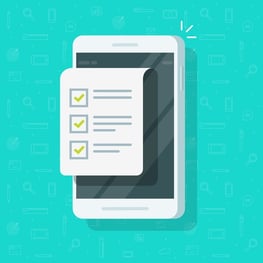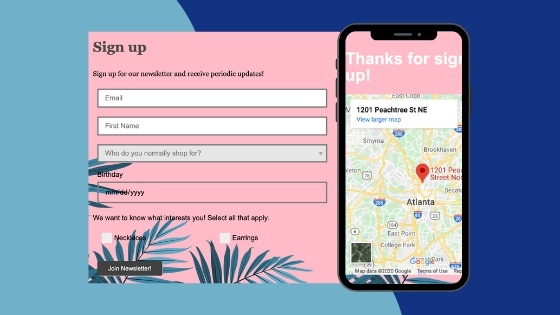More and more brands are embracing marketing personalization as an effective way to boost customer engagement and drive more sales. And yet, marketers face a persistent challenge to collect the right data that will enable them to create customized content that’s actually useful.
You might not realize it, but there’s a set of simple tools that can be used to seriously step up your marketing personalization game, and they’re probably already on your website right now: signup forms.
Why use them to drive personalization? For starters, shoppers have really warmed up to customized content. Ninety percent of consumers say they find marketing personalization ‘very’ or ‘somewhat’ appealing.
Personalization is also ultra-effective at getting more of your prospective customers to engage and buy from you. For email marketing, it’s the number one tactic you can use to drive conversions. And, in case you were wondering, email is the channel where marketing personalization is most commonly used, with 77 percent of marketers saying they used customized content like targeted product recommendations in emails.
Ready to learn how to use signup forms as an engine for data collection? Read on for strategies that will help you build customized content that drives more of your visitors to convert.
Collect The Basics
First things first, you want to know the basics. Name and email are a must to start with. From there, what matters to you will vary based on your industry and what kind of product you sell.
Some more basic pieces of information you might want to collect in your standard onsite signup form include location, birthday, or job title.

Remember, though, just because you can ask for a ton of personal details doesn’t mean you should. The fewer the fields, the higher the form completion rate, so you should keep your requests limited to the information you plan on putting to a direct use, like asking for city in order to send location-specific event information or asking for birthdate to offer a celebratory discount each year.
And if you can, avoid making phone number a required field at all costs. 37 percent of people will abandon a form that asks for their phone number. If the phone number field is optional, though, it doubles the completion rate.
Get Creative With Your Use of Forms
So, if you’re supposed to limit your forms to the fewest fields possible, how are you ever supposed to gather a meaningful volume of customer data? The answer is simple: by thinking outside the box with how you use them.
First, make use of dynamic forms, which show different fields to customers based on the information you already have. For example, if you already know a customer’s birthdate, your dynamic form might instead display a field that asks how often they shop with you. This way, you can piece together a broad data set over time without overwhelming users with endless form fields.
Another creative form feature are hidden fields. These aren’t shown to the front-end viewer, but capture valuable browsing information like the user’s traffic source, which page they converted on and how many times they’ve visited your website. All of these can be useful data points for creating customized content.
Next, get creative with how and where you use signup forms. They shouldn’t be reserved for just your footer and your Contact Us page. Instead, entice customers to complete additional form fills with special offers, like a limited-time discount code or a free gift with purchase.
And if you want to get that fiercely-guarded cell phone number? Incentivize it with its own form and an extra-special reward only available in exchange for a phone number. Mobile rewards programs and loyalty discounts are great options.
Ask Customers About Their Preferences
So many marketers sit back and wish they had a crystal ball that could tell them what their customers want and need. They forget that we have the power to ask them!

To facilitate customized content, use your signup forms to learn more about your customers’ shopping behaviors and content preferences. If you sell apparel, for example, you might offer checkboxes for users to select what kind of content they want to receive, with choices for trend alerts, new releases, sales and promotions, or all of the above.
You can also ask about how customers want to be contacted and how often to further enhance marketing personalization. In fact, customers prefer this. When asked about having targeted shopping recommendations sent to their mobile phones, 48 percent of consumers said they would find it acceptable if they had the option to opt-in or out, while 41 percent said it would be acceptable if the offers were tied to their previous purchasing history.
Make It Worth Their While
These days, consumers guard their personal information more closely than ever before. In a survey of Americans, 97 percent of people said they were ‘somewhat’ or ‘very’ concerned about protecting their personal data. This means it’s up to us to be good stewards of the information our subscribers choose to share with us.
No matter how you use onsite forms, there’s one best practice you should follow across the board: make it worth the customer’s while to fill them out. Reward the customer for entrusting you with their data through percentage or dollar-value discounts and other perks, like early access to your best sales.
Most importantly of all, use the intel you gather to create awesome tailored content that your customers actually want to receive. This not only builds goodwill toward your brand, but keeps customers coming back and adds to your bottom line.
Grow Your List and Personalize Your Marketing with Springbot Forms
Hopefully, these tips have sparked a few ideas for how to better customize your marketing content using forms. With Springbot’s newest feature, Springbot Forms, it’s easy to build great-looking signup forms that will enhance your marketing efforts.
By integrating your onsite forms with your customer database and email marketing efforts, you’ll send stronger messages that resonate more personally with your audience, which drives conversions. Get started with Springbot forms today.




